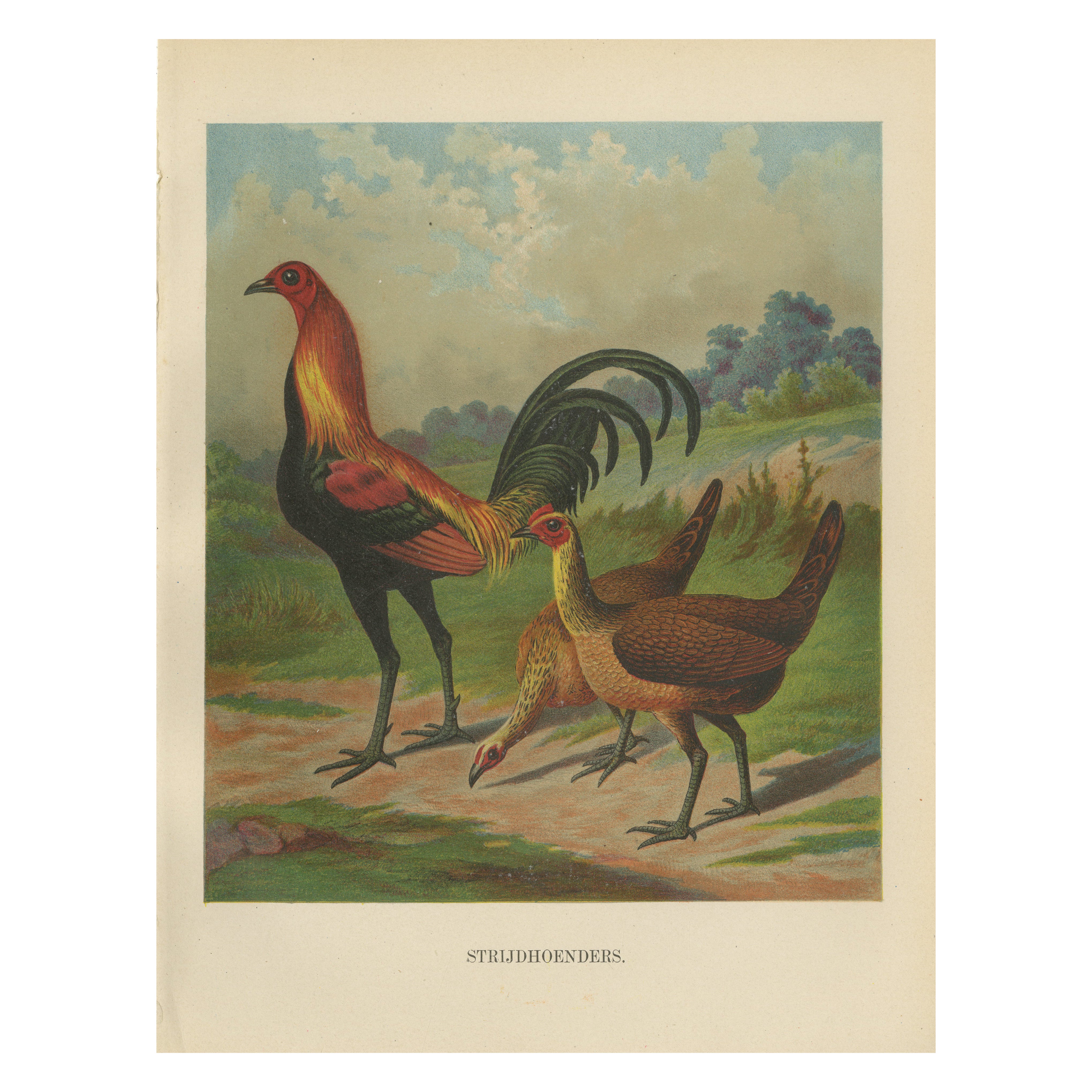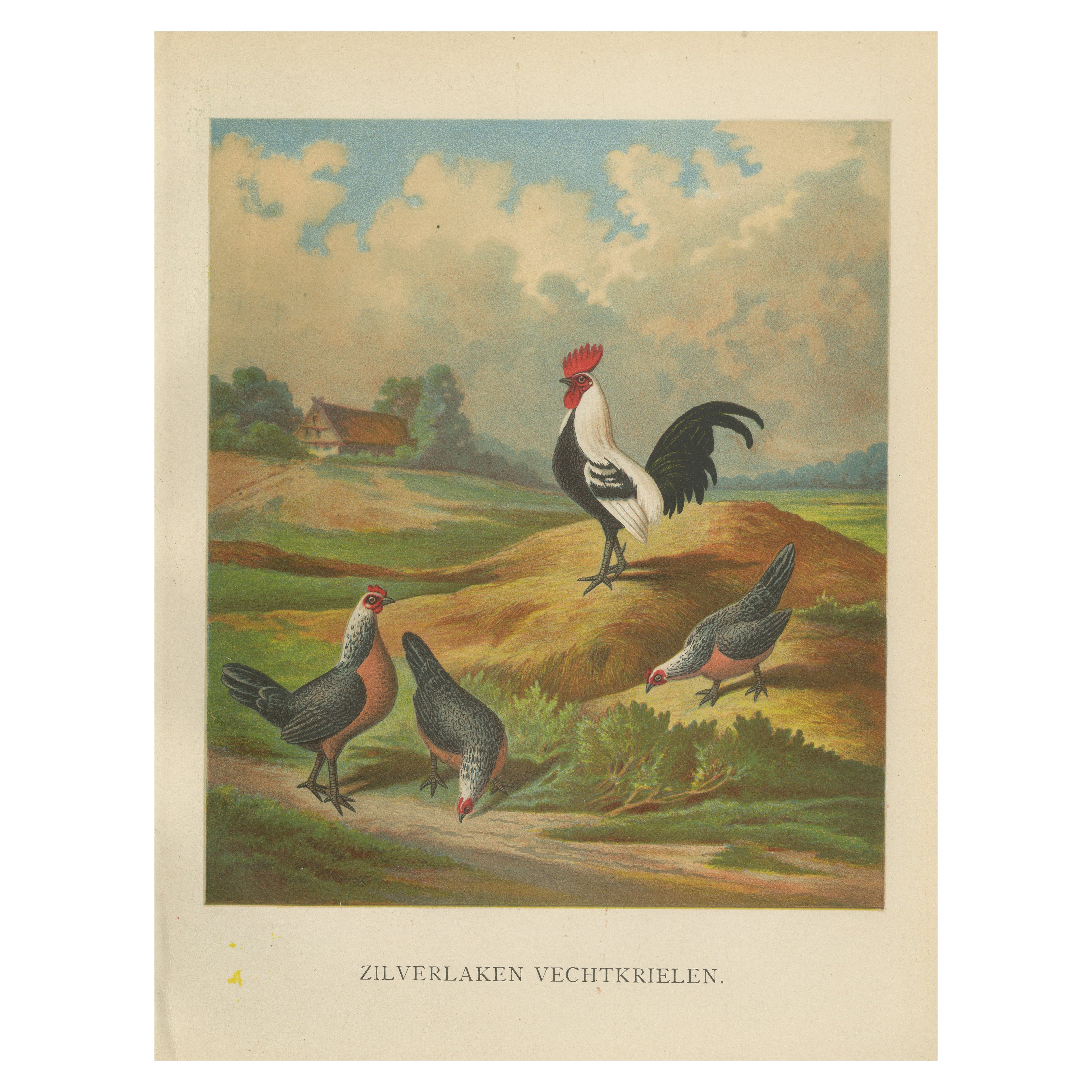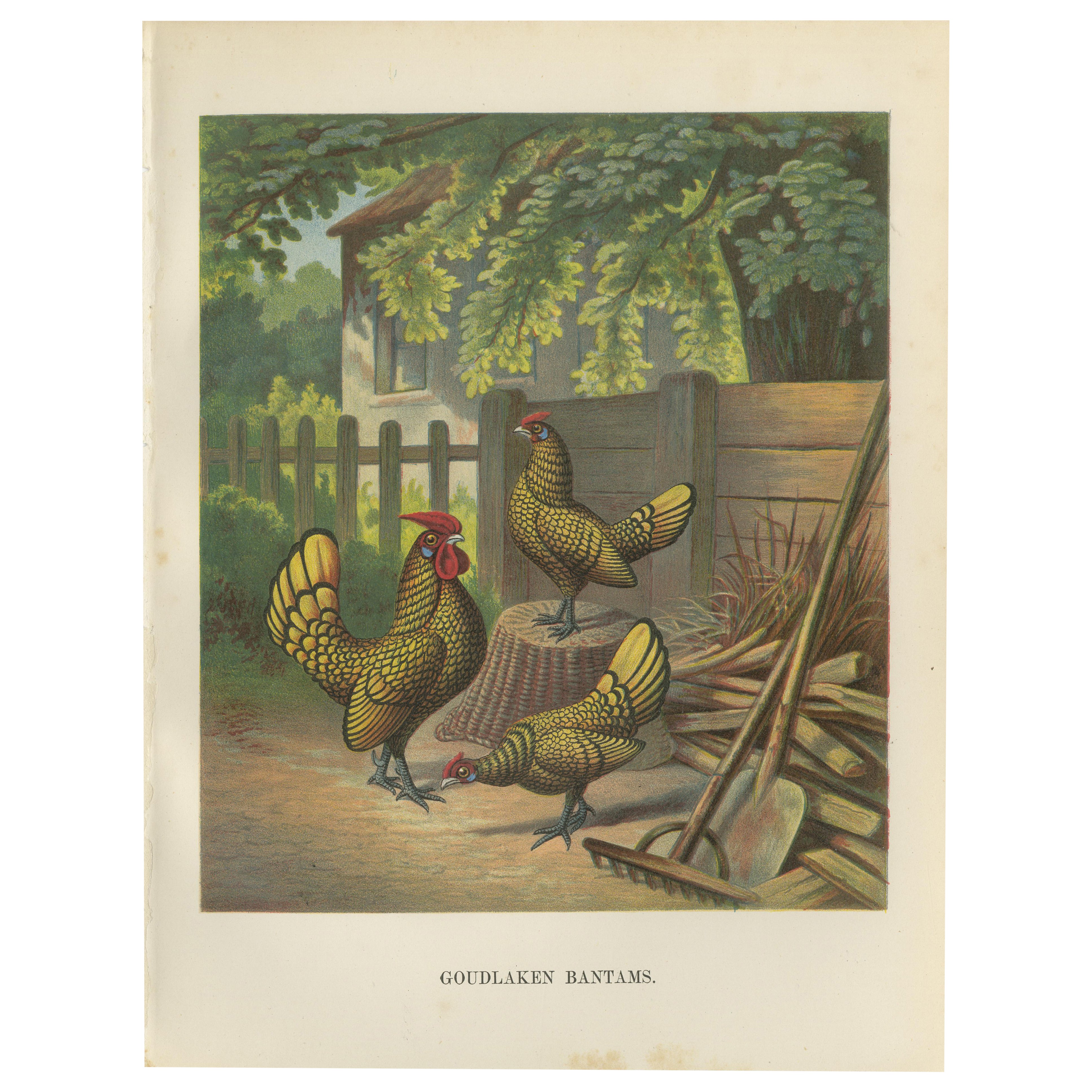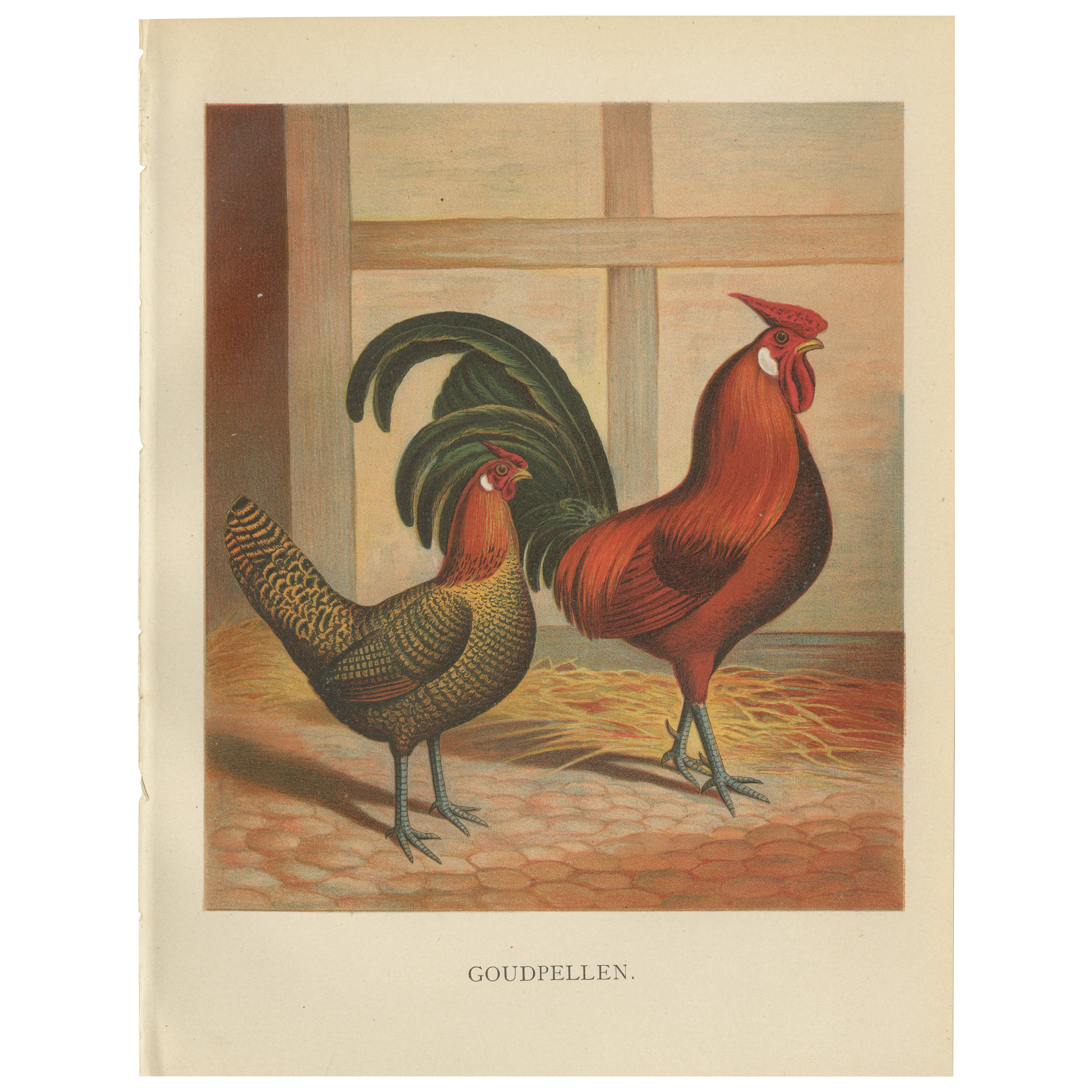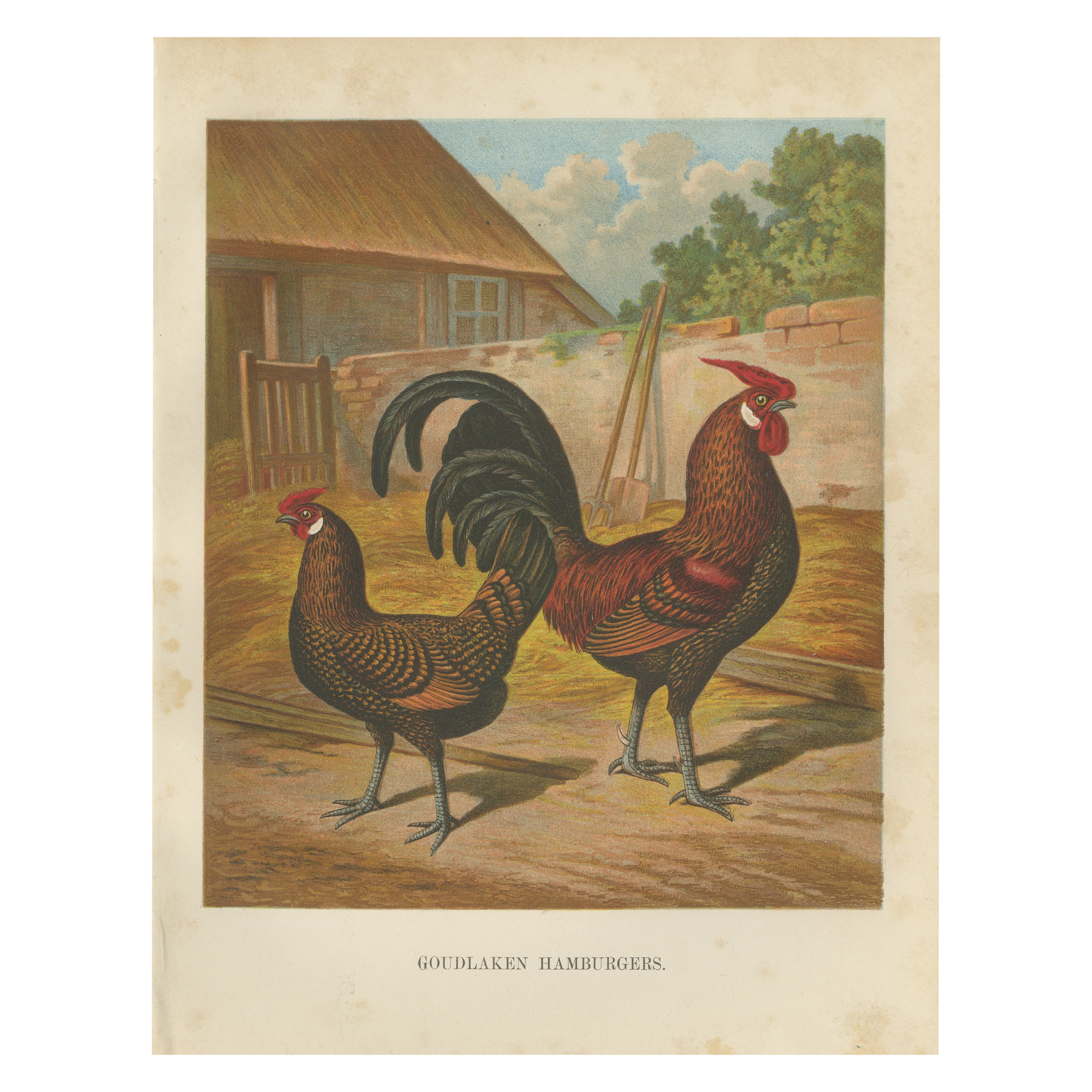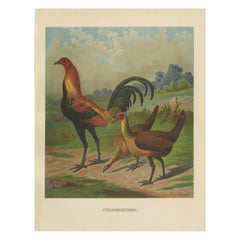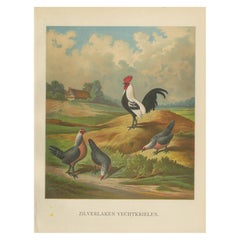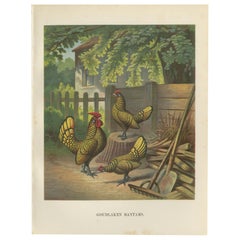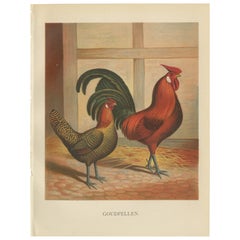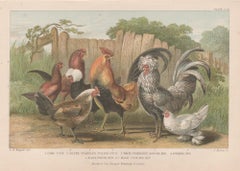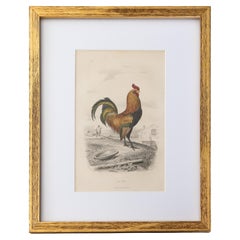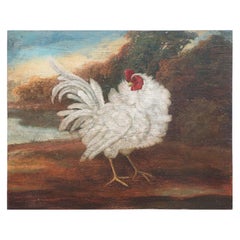Items Similar to The Lively Golden Bantam Game Fowl - A Rare 19th Century Poultry Lithograph
Want more images or videos?
Request additional images or videos from the seller
1 of 10
The Lively Golden Bantam Game Fowl - A Rare 19th Century Poultry Lithograph
$287.03
£211.75
€240
CA$397.35
A$430.85
CHF 228.64
MX$5,306.40
NOK 2,833.90
SEK 2,674.55
DKK 1,827.25
About the Item
The Lively Golden Bantam Game Fowl A Rare 19th Century Poultry Lithograph
This charming 19th century chromolithograph showcases a group of Golden Bantam Game Fowl, a small but spirited breed known for its vibrant plumage, energetic nature, and striking appearance. The print, titled Goudlaken Vechtkrielen, originates from Geïllustreerd Hoenderboek, an Illustrated Poultry Book published in 1888 by Elsevier. Compiled by Julius Volschau and adapted for Dutch readers by Dr. A. C. Oudemans Jzn., this book provided detailed insights into poultry breeding, featuring both utility and ornamental breeds highly valued in the 19th century.
The Bantam Game Fowl, also known as a fighting bantam, was bred for its agility, resilience, and bold demeanor. These birds were descendants of traditional game fowl but developed into a smaller form while maintaining the strong, upright posture and keen alertness of their larger counterparts. Despite their historical association with cockfighting, these bantams became favored among poultry enthusiasts for their decorative appeal and active personalities. The rooster in this lithograph stands proudly atop a wooden wheelbarrow, displaying its striking golden plumage with deep black and red highlights. The hens, with their delicate laced feathering, are seen foraging in the straw-covered farmyard, adding a dynamic and lively scene to the composition.
This lithograph was created using chromolithography, a meticulous 19th century printing process that allowed for vibrant and detailed color reproduction. The illustration is based on an original drawing by Christian Förster, a renowned animal illustrator of the time. Chromolithographs were produced by layering multiple colors, each applied with a separate stone plate, ensuring depth and realism in the final print. The careful rendering of the bantam’s delicate feather structure and rich coloration highlights the artistry involved in this technique.
Condition Summary
The print remains in very good condition, with well preserved colors and fine details. Some minor age related toning and light foxing spots are visible, particularly along the edges, which is common in lithographs of this period. The paper remains stable with minimal signs of wear, making this an excellent piece for collectors of antique poultry illustrations or those interested in historical agricultural prints.
Framing Tips
To best preserve and display this lithograph, consider the following framing techniques
- Use acid free matting to prevent long term deterioration. A soft cream or warm beige mat will enhance the golden tones of the bantam’s plumage
- Choose UV protective glass to safeguard the colors from fading due to light exposure
- A wooden frame in deep walnut, dark mahogany, or antique gold will complement the warm tones of the print
- Float mounting can be used if the original paper edges are to be highlighted, adding a historical and museum quality presentation
This lithograph is an exceptional example of 19th century poultry illustration, capturing the lively character and beauty of the Golden Bantam Game Fowl. Whether displayed in a farmhouse, study, or antique print collection, it remains a timeless and historically significant piece of agricultural art.
- Dimensions:Height: 10.63 in (27 cm)Width: 7.88 in (20 cm)Depth: 0.01 in (0.2 mm)
- Materials and Techniques:
- Period:
- Date of Manufacture:1888
- Condition:The print remains in very good condition, with well preserved colors and fine details. Some minor age related toning and light foxing spots are visible, particularly along the edges, which is common in lithographs of this period.
- Seller Location:Langweer, NL
- Reference Number:Seller: BG-14012-221stDibs: LU3054344066652
About the Seller
5.0
Recognized Seller
These prestigious sellers are industry leaders and represent the highest echelon for item quality and design.
Platinum Seller
Premium sellers with a 4.7+ rating and 24-hour response times
Established in 2009
1stDibs seller since 2017
2,620 sales on 1stDibs
Typical response time: <1 hour
- ShippingRetrieving quote...Shipping from: Langweer, Netherlands
- Return Policy
Authenticity Guarantee
In the unlikely event there’s an issue with an item’s authenticity, contact us within 1 year for a full refund. DetailsMoney-Back Guarantee
If your item is not as described, is damaged in transit, or does not arrive, contact us within 7 days for a full refund. Details24-Hour Cancellation
You have a 24-hour grace period in which to reconsider your purchase, with no questions asked.Vetted Professional Sellers
Our world-class sellers must adhere to strict standards for service and quality, maintaining the integrity of our listings.Price-Match Guarantee
If you find that a seller listed the same item for a lower price elsewhere, we’ll match it.Trusted Global Delivery
Our best-in-class carrier network provides specialized shipping options worldwide, including custom delivery.More From This Seller
View AllThe Proud Game Fowl - A Rare 19th Century Poultry Lithograph
Located in Langweer, NL
The Proud Game Fowl A Rare 19th Century Poultry Lithograph , 1888
This striking 19th century chromolithograph features a pair of game fowl, a breed known for its sleek, muscular build, long legs, and vibrant plumage. The print, titled Strijdhoenders, originates from Geïllustreerd Hoenderboek, an Illustrated Poultry Book published in 1888 by Elsevier. Compiled by Julius Volschau and adapted for Dutch readers by Dr. A. C. Oudemans Jzn., this book provided a detailed guide to poultry breeding, selection, and care, reflecting the significant role of game birds in both history and poultry exhibitions.
Game fowl are among the oldest chicken breeds, with origins tracing back thousands of years to Southeast Asia and the Indian subcontinent. Known for their exceptional agility and strong survival instincts, these birds were bred for their resilience and striking appearance. The rooster in this lithograph showcases the classic attributes of a game bird, with its slender frame, arched tail, and sharp, alert gaze. Its plumage features deep iridescent greens, fiery reds, and golden hues, creating a visually stunning contrast. The hen, though smaller, exhibits the same streamlined build with a warm brown and black feather pattern.
This lithograph was produced using chromolithography, a meticulous 19th century printing technique that allowed for vibrant and finely detailed illustrations. The artwork is based on an original drawing by Christian Förster, a renowned animal illustrator of the period. Chromolithographs were created by layering multiple colors, each applied with a separate stone plate, ensuring depth and realism in the final print. The careful rendering of the game fowl’s smooth feather texture and bold coloring highlights the craftsmanship involved in this technique.
Condition Summary
The print remains in very good condition, with well preserved colors and sharp details. Some minor age related toning and light foxing spots are visible, particularly along the edges, which is common in lithographs of this period. The paper remains stable, with minimal signs of wear, making this an excellent piece for collectors of antique poultry...
Category
Antique 1880s Prints
Materials
Paper
The Elegant Silver Bantam Game Fowl - A Rare 19th Century Poultry Lithograph
Located in Langweer, NL
The Elegant Silver Bantam Game Fowl - A Rare 19th Century Poultry Lithograph
This beautiful 19th century chromolithograph showcases a group of Silver Bantam Game Fowl, a small but agile breed known for its sharp, refined features and striking plumage. The print, titled Zilverlaken Vechtkrielen, originates from Geïllustreerd Hoenderboek, an Illustrated Poultry Book published in 1888 by Elsevier. Compiled by Julius Volschau and adapted for Dutch readers by Dr. A. C. Oudemans Jzn., this book provided detailed insights into poultry breeding, showcasing both utility and ornamental breeds that were highly valued in the 19th century.
Silver Bantam Game Fowl are direct descendants of traditional game birds but selectively bred into a smaller, more compact form while retaining their strength and alert nature. These birds were historically admired for their agility and resilience. The rooster in this lithograph stands proudly atop a small hill, displaying its elegant silver, black, and white plumage. The hens, with their refined body shape and soft silver laced feathering, are actively foraging, adding movement and a sense of realism to the composition.
This lithograph was produced using chromolithography, a meticulous 19th century printing process that allowed for vibrant and finely detailed illustrations. The artwork is based on an original drawing by Christian Förster, a renowned animal illustrator of the time. Chromolithographs were made by layering multiple colors, each applied with a separate stone plate, ensuring depth and realism in the final print. The delicate feather detailing and striking contrast in this print highlight the artistry involved in this technique.
Condition Summary
The print remains in very good condition, with well preserved colors and fine details. Some minor age related toning and light foxing spots are visible, particularly along the edges, which is common in lithographs of this period. The paper remains stable with minimal signs of wear, making this an excellent collectible piece for antique poultry...
Category
Antique 1880s Prints
Materials
Paper
The Golden-Laced Bantam - A Rare 19th Century Poultry Lithograph
Located in Langweer, NL
The Golden-Laced Bantam A Rare 19th Century Poultry Lithograph
This beautifully detailed 19th-century chromolithograph depicts a charming group of Golden-Laced Bantams, a breed kn...
Category
Antique 1880s Prints
Materials
Paper
The Majestic Golden Penciled Chicken - A Rare 19th Century Poultry Lithograph
Located in Langweer, NL
The Majestic Golden Penciled Chicken A Rare 19th Century Poultry Lithograph
This exquisite 19th century chromolithograph features a pair of Golden Penciled chickens, a breed known for its striking feather pattern, refined body shape, and graceful presence. The print, titled Goudpellen, originates from Geïllustreerd Hoenderboek, an Illustrated Poultry Book published in 1888 by Elsevier. Compiled by Julius Volschau and adapted for Dutch readers by Dr. A. C. Oudemans Jzn., this book provided detailed insights into poultry breeding, showcasing both practical and ornamental breeds that were highly valued in the 19th century.
The Golden Penciled variety is known for its intricate feather markings, especially in the hens, which display an elegant gold and black penciling pattern across their bodies. The roosters are equally impressive, with a rich golden-red hue, an upright stance, and a gracefully arched tail. This breed was admired not only for its aesthetic appeal but also for its active and hardy nature, making it a popular choice among poultry enthusiasts in the 19th century.
This lithograph was created using chromolithography, a sophisticated 19th century printing technique that allowed for vibrantly detailed and richly colored illustrations. The artwork is based on an original drawing by Christian Förster, a skilled animal illustrator of the time. Chromolithographs were produced by layering multiple colors, each applied with a separate stone plate, ensuring depth and realism in the final print. The precision in rendering the feather texture and vibrant golden tones in this lithograph highlights the artistry involved in this technique.
Condition Summary
The print remains in very good condition, with well preserved colors and sharp details. Some minor age related toning and light foxing spots are visible, particularly along the edges, which is common in lithographs of this period. The paper remains stable, with minimal signs of wear, making this an excellent collectible piece for antique poultry print...
Category
Antique 1880s Prints
Materials
Paper
The Distinguished Ramelsloher Chicken - A Rare 19th Century Poultry Lithograph
Located in Langweer, NL
The Distinguished Ramelsloher Chicken A Rare 19th Century Poultry Lithograph
This striking 19th-century chromolithograph features a pair of Ramelsloher chickens, a breed known for...
Category
Antique 1880s Prints
Materials
Paper
The Elegant Golden Spangled Hamburg Chicken - A 19th Century Poultry Lithograph
Located in Langweer, NL
The Elegant Golden Spangled Hamburg Chicken A Rare 19th Century Poultry Lithograph
This exquisite 19th century chromolithograph features a pair of Golden Spangled Hamburg chickens, an elegant and highly regarded breed known for its striking plumage, graceful build, and excellent egg laying capabilities. The print, titled Goudlaken Hamburgers, originates from Geïllustreerd Hoenderboek, an Illustrated Poultry Book published in 1888 by Elsevier. Compiled by Julius Volschau and adapted for Dutch readers by Dr. A. C. Oudemans Jzn., this book provided a comprehensive guide to poultry breeding, highlighting both practical and ornamental breeds that were highly valued in the 19th century.
Hamburg chickens are one of the oldest known domesticated poultry breeds, with records tracing them back to at least the 14th century. They were particularly popular in the Netherlands, Germany, and England due to their striking feather patterns and exceptional egg laying abilities. The Golden Spangled Hamburg, as depicted in this lithograph, is a particularly eye catching variety, featuring a rich golden brown base color accented with bold black spangling. The rooster stands tall with its flowing tail feathers and proud posture, while the hen, slightly smaller, displays the same intricate feather pattern in a more compact form.
This lithograph was created using chromolithography, a meticulous 19th century printing technique that allowed for vibrant and finely detailed illustrations. The artwork is based on an original drawing by Christian Förster, a skilled animal illustrator of the time. Chromolithographs were produced by layering multiple colors, each applied with a separate stone plate, ensuring depth and realism in the final print. The detailed feather patterning and the warm golden hues in this print highlight the craftsmanship involved in this artistic technique.
Condition Summary
The print remains in good condition, with well preserved colors and sharp details. Some minor age related toning and visible foxing spots are present along the edges, which is common in lithographs of this period. The paper remains stable, with slight signs of wear, making this an excellent collectible piece for antique poultry print...
Category
Antique 1880s Prints
Materials
Paper
You May Also Like
Poultry, English antique bird engraving print, 1879
Located in Melbourne, Victoria
Poultry
Wood-engraving with original colouring. 1879.
160mm by 245mm (sheet).
Key below the image. From Oliver Goldsmith's 'A History of the Earth and Animated Nature'.
Category
Late 19th Century Victorian Animal Prints
Materials
Engraving
Custom Framed Antique Rooster Engraving
By Georges-Louis Leclerc, Comte de Buffon
Located in Pearland, TX
Georges-Louis Leclerc, Count of Buffon (1707-1788) was a French naturalist, mathematician, and cosmologist. Buffon published thirty-six quarto volumes of his most well-known work, Hi...
Category
Antique 1850s French Decorative Art
Materials
Other
Chicken Family - Lithograph by W. French - Late 19th Century
Located in Roma, IT
A Chicken Family is an original print realized by William French (1815 ca.-1898) in the late 19th century.
Black and white lithograph. Original Title: ...
Category
Late 19th Century Animal Prints
Materials
Lithograph
Rooster in Nature Print on Wood
Located in Queens, NY
English Victorian style (20th Century) print of a rooster standing on red clay and looking to the side, in front of a blue pond and autumnal trees, on...
Category
20th Century American Mid-Century Modern Paintings
Materials
Wood
Rooster in Nature Print on Wood
Located in Queens, NY
English Victorian style (20th Century) print of a rooster standing on red clay and looking to the side, in front of a blue pond and autumnal trees, on...
Category
20th Century American Mid-Century Modern Paintings
Materials
Wood
A Small Signed 19th Century French Oil on Canvas Painting of a Rooster and Hen
Located in Dallas, TX
More information coming soon…
This small French oil painting on canvas from the 1800s depicts a bright rooster and a less vibrant hen. Sign...
Category
Antique 19th Century French Paintings
Materials
Canvas, Wood, Paint
